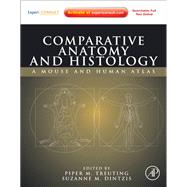Comparative Anatomy and Histology

Comparative Anatomy and Histology
- ISBN 13:
9780123813619
- ISBN 10:
0123813611
- Edition: 1st
- Format: Hardcover
- Copyright: 12/16/2011
- Publisher: Elsevier Science
Rent
Sorry, this item is currently unavailable on Knetbooks.com
Note: Supplemental materials are not guaranteed with Rental or Used book purchases.
Extend or Purchase Your Rental at Any Time
Need to keep your rental past your due date? At any time before your due date you can extend or purchase your rental through your account.
Summary
Biomedical research institutions worldwide are literally over run with mice. Sixty percent of extramural NIH funded grants use animals and approximately 90% of these are mouse models. Mice are also extensively used in the discovery or preclinical phase of drug development. This is a testament to the perceived utility of mice to model human conditions and conduct hypothesis-driven research. Mouse models have proven valuable to biomedical research but only with careful validation and translation of the mouse data to human conditions. A mouse model that is not appropriately validated is a waste of animals and research dollars and can result in risks to human health when mouse preclinical data is incorrectly translated to human patients. The development and validation of mouse models involves many people from undergraduates and research technicians to principle investigators and project leaders. Increasingly, the mice are genetically modified so that they are not only mice, but mutant mice. We are awash in "weird" mice; what to make of them? If the biomedical research institute or research group is lucky enough to have a comparative pathologist as a colleague or collaborator, the comparative pathologist often has the final word on the validity of the mouse model by determining what is "weird" and what is just mouse. Unfortunately, the population of skilled comparative pathologists is not increasing as rapidly as the mice. The interpretation of mouse pathology and the translation of pathologic findings to a valid mouse model of human disease require broad and unique skills. Trained comparative pathologists have attended veterinary or medical school and have further specialty training in pathology. The comparative mouse pathologist must also understand how a research question may be impacted by the interplay of the mouse background strain, genetic manipulations, breeding schema, sex, housing, diet, age and intercurrent pathogenic or commensal organisms. There are not enough trained comparative pathologists to help make sense of this glut of#xA0;mice. Comparative Anatomy and Histology: A Mouse and Human Atlas is aimed at#xA0;both medical and veterinary#xA0;pathologists who need to expand their knowledge base into comparative pathology. It guides the reader through normal mouse histology using direct comparison to human histology. The side by side comparison of mouse and human tissues highlight the unique biology of the mouse, which has great impact on the histopathology of human disease. * Presents the first comprehensive source for comparing human and mouse anatomy and histology in one reference work * Experts from both human and veterinary pathology take readers through each organ system in a side-by-side comparative approach to anatomy and histology * Human and veterinary pathologists who are not well trained in true comparative pathology will use this atlas to#xA0;examine tissue samples with greater accuracy and confidence * Biomedical researchers will learn how to examine the histologic changes in their mutant mice without having to find a trained comparative pathologist








